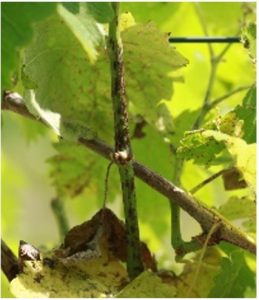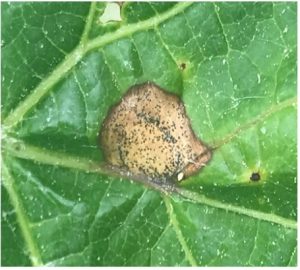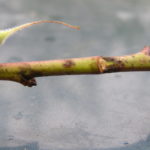Peach:
Bacterial Spot: Bacterial spot fruit symptoms are increasing statewide. The first infections occurred during the mothers day storm. So far levels of fruit infection are very low however we still have not yet seen the development of symptoms from recent rain events. Leaf symptoms appear after 1 week and fruit symptoms take 3 weeks to appear. Growers should continue to manage aggressively to suppress infections. Fruit will become less susceptible to infection at pit hardening which is occurring now.
Oriental Fruit Moth: A biofix point for OFM was set on 4/11 in southern counties, and on 4/14 in northern counties. The second generation timings are updated below.
| Insecticide Type | |||
| County/Region | Degree Days by 6/8 base 45 | Conventional
1150-1200 1450-1500 |
Diamide
1075-1150 1375-1450 |
| Gloucester – Southern | 796 | 1st –6/14-6/16
2nd –too far off |
1st –6/12-6/15
2nd –too far off |
| Middlesex – Northern | 882 | 1st –6/19-6/21
2nd –too far off |
1st –6/18-6/21
2nd –too far off |
Plum Curculio; Tarnished Plant Bugs; and Other Catfacing Insects: Plum Curculio start to move into orchards at about 88-100 degree days base 50 after January 1. Applications for PC should be initiated once all petals are off, with a second application made with ovicidal materials at 379-402 DD. Growers can monitor degree day development at their site by finding the nearest weather station and using the degree day development tool at NEWA. PC activity should be past peak and decreasing except in high pressure orchards. Catfacing insect activity is increasing with the arrival of hot weather and are present at moderate to high levels in some orchards.
Lesser Peach Tree Borer and Peach Tree Borer: Lesser Borer adults are flying in all growing regions. Greater Peach tree borers are now flying in southern counties.
Apples and Pears:
Diseases: Fire blight and Scab are present at low levels in a few orchards. Fire Blight should be cut out using the ugly stub method. Summer scab, rots and sooty blotch and fly speck are the main targets at this stage. Where scab is present rely primarily on protectant fungicides. Last year Captan plus a phosphite like Prophyt was observed to slow scab development as well as provide good summer disease control.
Codling Moth (CM): The first codling moth flight has started. A biofix was set for CM on April 25th in southern counties, and May 6 in Northern counties (Middlesex County). No biofix has yet been set for northern counties. Timings are updated below.
| Codling Moth Degree Day Timing | ||||||||
| Application and Insecticide Type | ||||||||
| County Area | Biofix | Rimon:
75-100DD + 14-17 days later
|
Intrepid
150 + 450 DD Diamides – Altacor, Voliam mixes: (150-200 DD) + 14-21 days later |
Cyd-X, Madex
250 DD + every 7-9 days during brood hatch (later if first spray is an IGR) |
Standard Insecticides – Delegate, Avaunt, OP’s, carbamates, pyrethroids
250 DD + 550 DD
|
|||
| DD | 75 | 100 | 150 | 450 | 250 | 250 | 550 | |
| Southern | April 25 | past | past | past | past | past | past | past |
| Northern | May 6 | past | past | past | past | past | past | 6/9 |
Tufted Apple Budmoth (TABM): Tufted Apple Budmoth (TABM): A biofix was set statewide on May 6. The first alternate middle applications for TABM will be on or about June 1 in all counties. This has been considered a minor pest in recent years. With the exception of Assail and and granulosis virus formulations (e.g. Madex), most materials used for Codling Moth will control TABM.
Grapes:
Diseases: Grape diseases active at this growth stage are phomopsis, powdery mildew, downy mildew, and black rot.

Phomopsis on grape leaves and cane. (Photo – D. Schmitt)

Black rot leaf lesion on grape (Photo – D. Schmitt)
Phomopsis symptoms are present in southern counties. Black rot symtpoms have not yet been observed but should appear any time now. Disease infection periods can be monitored using the NEWA models. Choose the weather station closest to your vineyard.
Insects: Leafhoppers have been seen in a few spots. This complex is generally not of concern. Potato leafhoppers, which arrive sometime in June, can cause some minor damage. Spotted Lantern Fly nymphs are present in high numbers on many vineyards. These nymphs do little damage and generally don’t need special treatments when present. Even so, vineyards should be monitored for SLF presence and if they are found use an insecticide effective for SLF when treating for Grape Berry Moth in late June.
Grape Berry Moth (GBM): The biofix in southern counties for GBM was 5/25. Model timing will predict IGR and diamide materials for the second generation. The first generation is not really important in cultivated grapes, but is starting now in wild grapes, with some adults starting to come into vineyards. Timing for the second generation treatments using Diamides or Intrepid is set at 810 degree days base 470F. Other materials may be applied a few days later. Given the current weather patterns, this should be about the last week of June in southern counties.
Tree Fruit Trap Counts – Southern Counties
| Weekending | STLM | TABM-A | CM | AM | OFM-A | DWB | OFM-P | TABM-P | LPTB | PTB |
| 4/9/2022 | 2 | 0 | 0 | |||||||
| 4/16/2022 | 0 | 2 | 3 | |||||||
| 4/23/2022 | 11 | 0 | 0 | 28 | 5 | 0 | 0 | |||
| 4/30/2022 | 5 | 0 | 1 | 31 | 4 | 0 | 0 | |||
| 5/7/2022 | 5 | 1 | 3 | 50 | 4 | 0 | 0 | |||
| 5/14/2022 | 8 | 5 | 3 | 19 | 2 | 0 | 0 | |||
| 5/21/2022 | 3 | 5 | 5 | 20 | 2 | 7 | 3 | |||
| 5/28/2022 | 0 | 19 | 3 | 13 | 0 | 11 | 36 | |||
| 6/4/2022 | 0 | 10 | 3 | 5 | 1 | 13 | 49 | 0 |
Tree Fruit Trap Counts – Northern Counties
| Weekending | STLM | TABM-A | CM | AM | OFM-A | DWB | OFM-P | TABM-P | LPTB | PTB |
| 4/9/2022 | ||||||||||
| 4/16/2022 | 0 | 0 | 1 | |||||||
| 4/23/2022 | 0 | 0 | 2 | 0 | ||||||
| 4/30/2022 | 0 | 0 | 2.5 | 0 | ||||||
| 5/7/2022 | 0 | 1 | 4 | 0 | ||||||
| 5/14/2022 | 1 | 2 | 0 | 5 | 0.5 | 0 | 0 | |||
| 5/21/2022 | 6 | 8 | 4 | 27 | 2 | 5 | 6 | 5 | 0 | |
| 5/28/2022 | 34 | 19 | 3 | 6 | 13 | 1 | 23 | 15 | 0 | |
| 6/4/2022 | 17 | 21 | 4 | 4 | 11 | 1 | 27 | 17 | 0 |
| Pest Event or Growth Stage | Approximate Date | 2022 Observed Date |
| Bud Swell (Redhaven) | March 23 +/- 15 Days | March 20 |
| 1/4″ Green Tip Red Delicious | March 31 +/- 13 Days | March 21 |
| Pink Peach (Redhaven) | April 4 +/- 15 Days | March 31 |
| Tight Cluster Red Delicious | April 9 +/- 13 Days | March 31 |
| Full Bloom Peach (Redhaven) | April 9 +/- 14 Days | April 10 |
| Pink Apple (Red Delicious) | April 14 +/- 12 Days | April 14 |
| Full Bloom Apple (Red Delicious) | April 22 +/- 11 Days | April 21 |
| Petal Fall (Redhaven) | April 22 +/- 10 Days | April 14 |
| Petal Fall (Red Delicious) | April 27 +/- 13 Days | May 3 |
| Shuck Split (Redhaven) | April 30 +/- 11 Days | April 26 |
| Pit Hardening | June 15 +/- 9 Days | June 10 |

